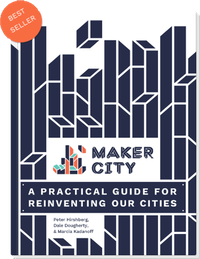Reviewers Guide
Maker City: A practical guide to reinventing our cities
This book fits into the narrative and conversation started in
The Metropolitan Revolution: How Cities and Metros Are Fixing Our Broken Politics and Fragile Economy by Bruce Katz (Brookings Institution) and Jennifer Bradley (Aspen Institute).
Instead of focusing on what is wrong with our cities,Maker City focuses on what is going right: a resurge in energy and focus inside our cities thanks to the Maker movement, which is reshaping virtually all the institutions that make up our cities: schools, libraries, community centers, churches, workforce development, workforce development. Most importantly, the authors point out how the Maker movement is encouraging people of all ages to find a new sense of agency through working with their hands and creating products as opposed to consuming them.
This thread picks up on a discourse that President Obama started back in 2014 when he announced the first ever National Week of Making and Makers Faire:
“Our parents and grandparents created the world’s largest economic and strongest middle class not by buying stuff but by building stuff – by making stuff, by tinkering and inventing and building.”
It was this activity at the White House, plus a conference with mayors sponsored by the Kauffman Foundation, that was very much the genesis for the Maker City book.
Maker City describes the many experiments that are happening inside our cities, especially around urban manufacturing. A key point is that we need to rethink what progress looks like, to move away from a definition of progress where “big” is always better. In fact, when talking to people who live and work inside Maker City(s), the authors found that job creation in manufacturing was happening through the concentration of many small and medium-sized efforts. This turns the traditional notion of workforce and economic development on its head.
In the past, cities worked hard to attract one or more signature company to move to their city with a series of incentives. The problem with this is that the jobs that were created were not deeply rooted in the local ecosystem.
The authors–Peter Hirshberg, Dale Dougherty, and Marcia Kadanoff–provide tools to map the local ecosystem in your city, identify gaps, as well as over 96 recommendations on how to make economic opportunity flourish by leveraging the Maker movement. The recommendations are practical and key coded so policy leaders, activists, business leaders, and civic innovations can zone in and find quick wins, implementation advice, big ideas, policy recommendations, and resources to help effect change.
Maker City: A Practical Guide to Reinventing Your City was produced through the generosity of the Ewing Marion Kauffman Foundation and is available on Amazon now at http://mcbook.me/amaz100 in both Paperback (270 pages) and Kindle format.
Resources
- Maker City book on Medium
- Maker City promotional ideas with supporting graphics
- Book review guidelines

